Sandomierz
Sandomierz (pronounced: [sanˈdɔmʲɛʂ] (![]()
Sandomierz | |
|---|---|
 Market Square with the Town Hall | |
 Flag 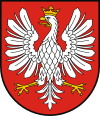 Coat of arms | |
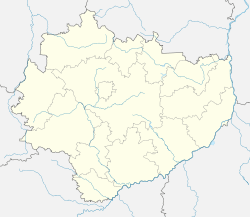 Sandomierz  Sandomierz | |
| Coordinates: 50°41′N 21°45′E | |
| Country | |
| Voivodeship | |
| County | Sandomierz County |
| Gmina | Sandomierz (urban gmina) |
| Town rights | before 1227 |
| Government | |
| • Mayor | Marcin Marzec[1] |
| Area | |
| • Total | 28.8 km2 (11.1 sq mi) |
| Elevation | 200 m (700 ft) |
| Population (2017[1]) | |
| • Total | 23,863 |
| • Density | 830/km2 (2,100/sq mi) |
| Time zone | UTC+1 (CET) |
| • Summer (DST) | UTC+2 (CEST) |
| Postal code | 27-600 |
| Area code(s) | +48 15 |
| Car plates | TSA |
| Website | sandomierz.pl |
Etymology
The name of the city might have originated from the Old Polish Sędomir, composed of Sędzi- (from the verb sądzić "to judge") and mir ("peace"), or more likely from the antiquated given name Sędzimir, once popular in several Slavic languages.[2] Sandomierz is known in German: Sandomir; Latin: Sandomiria; Yiddish: צויזמיר, romanized: Tzoyzmir; Hungarian: Szandomir; Ukrainian: Сандомир or Судомир; Russian: Сандомир; and Czech: Sandoměř.
History
Early history
Sandomierz is one of the oldest and historically most significant cities in Poland. Archeological finds around the city indicate that humans have inhabited the area since neolithic times. The city came into existence in the early Middle Ages, taking advantage of an excellent location at the junction of Vistula and San rivers, and on the path of important trade routes. The first known historical mention of the city comes from the early 12th-century, when the chronicler Gallus Anonymus ranked it together with Kraków and Wrocław as one of the main cities of Poland. The testament (ca 1115-1118) of Bolesław III Wrymouth, in which he divided Poland among his sons, designated Sandomierz as the capital of one of the resulting principalities, the Duchy of Sandomierz.

In the early 13th century, the second oldest Dominican monastery in Poland (after Kraków) and one of the oldest in Europe was founded in Sandomierz. In the course of the 13th century the city suffered grievous damage during the raids by Mongols in 1241, 1260 and 1287. The old wooden buildings of the town were completely destroyed. As a result, in 1286 the High Duke of Poland Leszek II the Black, effectively refounded the city under Magdeburg Law and granted staple right.[3] The city archives preserve the founding document. (An important note: in 1260, as the Tartars invaded Christian Sandomir, a community of Dominicans was praying Matins while a novice read the martyrology for the next day: "the 49 martyrs of Sandomir". When the friars realized they were being warned of their death, they spent the remainder of the night and all the next day preparing to meet the Lord. At last, after the brethren had finished praying Compline, and as they processed singing the Salve Regina to Mary, the Tartars broke through the church door. While the Tartars intended to bring death to these Dominicans, they actually brought them great gifts - crowns of martyrdom. Ever since, at the death of every Dominican a song to his Beloved Mother is sung to usher him into her arms - the Salve Regina (or Hail, Holy Queen).[4])
After the re-unification of the Polish lands in the 14th century, the former principality became the Sandomierz Voivodeship, incorporating large areas of southeastern Poland. Until 1474, it was one of two voivodeships (administrative area/province) of Lesser Poland, together with Krakow Voivodeship (Krakowskie). In 1474, Lublin Voivodeship (Lubuskie) was created from eastern part of Sandomierz Voivodeship (Sandomierskie). At this time Sandomierz had about 3,000 inhabitants and was one of the largest Polish cities. In the middle of the 14th century the city was burned again during a raid by the Lithuanians. It was rebuilt during the rule of king Casimir III of Poland, who extended its privileges.[5] The layout of the city has survived practically unchanged since that time until the present day. In 1389 in Sandomierz the newly appointed prince of the Novgorod Republic, Lithuanian prince Lengvenis, paid homage to Polish King Władysław II Jagiełło, thus making Novgorod a fiefdom of the Kingdom of Poland.[6]
Modern era

In 1570 an alliance of non-Catholic Polish Churches, the Lutherans, the Reformed, and the Bohemian Brethren, drew up what is known as the Sandomierz Agreement, effecting a confederation of the work in order to stave off defeat at the hands of the Roman Church. Thanks to the efforts of the local starost Hieronim Gostomski, the Jesuits settled in the city and founded the Collegium Gostomianum,[5] one Poland's oldest high schools, at the beginning of the 17th century.
The early modern period, running until the middle of the 17th century, was quite prosperous for the city. The most important historical buildings were built during this period. This golden age came to an end in 1655 when Swedish forces captured the city in the course of the Deluge. After briefly holding out in the city, the withdrawing Swedes blew up the castle and caused heavy damage to other buildings. In the next 100 years the economy of Poland suffered a decline, which also affected the city. A great fire in 1757 and the First Partition of Poland in 1772, which placed Sandomierz in Austria, further reduced its status. As a result, Sandomierz lost its role as an administrative capital.
In 1809, during the Napoleonic Wars, fighting between the forces of Austria and of the Duchy of Warsaw caused damage to the city. It became part of the short-lived Polish Duchy of Warsaw and after 1815 it found itself in the Russian Empire (Congress Poland). At this point it had just 2640 inhabitants.
Sandomierz Cathedral and St Paul's Church blood libel myth
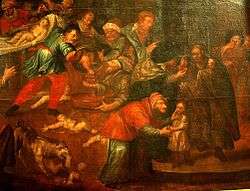
This cathedral contains a series of paintings built into the church's wooden panelling depicting the Martyrologium Romanum. The third painting shows the scene which, it is claimed:[7] "...depicts ritual murders committed in Sandomierz by Jews on Christian children. The inscription above the painting reads filius apothecary ab infidelibus judaeis sandomiriensibus occisus (son of an apothecary, by infidel Sandomierz Jews killed) [8]
The St Paul's Church contains a different series of paintings including one in the chancel, depicting the torment of Jerzy Krassowski who was allegedly strangled by the Jews. Discussion on these pictures has taken place with the participation of the Polish Jewish Community. "The Polish Council of Christians and Jews has offered to finance a plaque with explanations of the blood libel and information about the official statements by various Popes rejecting the accusation".[9] This plaque is now displayed in the St Paul's Church next to the picture in question.
Fr. Stefan Zuchowski (1660-1716) from Sandomierz wrote two books propagating the myth of blood libel.[10] He also took an active role in two ritual murder trials in Sandomierz which led to the murder of five Jews and were the inspiration for the paintings displayed in Sandomierz Cathedral and St Paul's Church.
The world wars
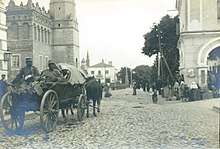
The city again suffered damage during World War I. In 1918, it again became part of independent Poland. In the 1930s, due to the massive public works project known as the Central Industrial Area, Sandomierz began to grow quickly. It was projected to become capital of the Sandomierz Voivodeship, and local authorities planned fast development of the city. The Greater Sandomierz was to turn in the 1940s into a city of 120,000.
In September 1939, following the German invasion of Poland, the city was occupied by Germany and made part of the General Government. The Jewish population of the city, consisting of about 2,500 people, perished during the Holocaust, mostly in the death camps of Bełżec and Treblinka. The city was captured by the Red Army in August 1944.
No major industrial development took place in Sandomierz during the communist era, thus preserving its look of a charming, small city full of historical monuments among the unspoiled landscape.
Climate
The city experiences a humid continental climate with notably warm summers (Köppen: Dfb), much more consistently pronounced in eastern Poland. Precipitation, especially in the form of rains, is concentrated in the summer, reducing until the end of winter. Sandomierz has four well defined seasons of the year, hot summers (sometimes), usually bearable and cold winters but with slightly moderate extremes.[11]
| Climate data for Sandomierz (Chwałki), elevation: 217 m, 1961-1990 normals and extremes | |||||||||||||
|---|---|---|---|---|---|---|---|---|---|---|---|---|---|
| Month | Jan | Feb | Mar | Apr | May | Jun | Jul | Aug | Sep | Oct | Nov | Dec | Year |
| Record high °C (°F) | 10.5 (50.9) |
18.7 (65.7) |
23.6 (74.5) |
28.3 (82.9) |
30.2 (86.4) |
34.0 (93.2) |
35.9 (96.6) |
33.6 (92.5) |
30.7 (87.3) |
25.2 (77.4) |
19.8 (67.6) |
16.0 (60.8) |
35.9 (96.6) |
| Average high °C (°F) | −1.1 (30.0) |
1.1 (34.0) |
6.3 (43.3) |
13.2 (55.8) |
18.8 (65.8) |
21.8 (71.2) |
23.2 (73.8) |
22.8 (73.0) |
18.6 (65.5) |
12.9 (55.2) |
5.9 (42.6) |
1.0 (33.8) |
12.0 (53.7) |
| Daily mean °C (°F) | −3.9 (25.0) |
−2.2 (28.0) |
2.0 (35.6) |
8.0 (46.4) |
13.4 (56.1) |
16.5 (61.7) |
17.8 (64.0) |
17.2 (63.0) |
13.2 (55.8) |
8.3 (46.9) |
2.9 (37.2) |
−1.4 (29.5) |
7.7 (45.8) |
| Average low °C (°F) | −6.8 (19.8) |
−5.0 (23.0) |
−1.3 (29.7) |
3.6 (38.5) |
8.5 (47.3) |
11.5 (52.7) |
12.8 (55.0) |
12.5 (54.5) |
9.0 (48.2) |
4.6 (40.3) |
0.4 (32.7) |
−3.8 (25.2) |
3.8 (38.9) |
| Record low °C (°F) | −27.3 (−17.1) |
−26.4 (−15.5) |
−22.1 (−7.8) |
−4.9 (23.2) |
−1.7 (28.9) |
0.2 (32.4) |
5.4 (41.7) |
3.8 (38.8) |
−2.3 (27.9) |
−7.4 (18.7) |
−16.8 (1.8) |
−26.4 (−15.5) |
−27.3 (−17.1) |
| Average precipitation mm (inches) | 29 (1.1) |
27 (1.1) |
27 (1.1) |
38 (1.5) |
61 (2.4) |
80 (3.1) |
86 (3.4) |
69 (2.7) |
43 (1.7) |
37 (1.5) |
37 (1.5) |
34 (1.3) |
568 (22.4) |
| Average precipitation days (≥ 1.0 mm) | 6.9 | 6.9 | 6.8 | 6.9 | 9.6 | 10.3 | 10.3 | 8.0 | 8.0 | 6.2 | 8.3 | 8.8 | 97 |
| Source: NOAA[12] | |||||||||||||
Points of interest

- Church of the Holy Spirit in Sandomierz
- Church of St. Jacob where Lesser Polish Way begins
- Sandomierz Church of St. Joseph
- Sandomierz Church of St. Michael
- Sandomierz Church of St. Paul
- Collegium Gostomianum, one of the oldest schools in Poland founded in 1602
- Jan Długosz House
- Kamienica Oleśnickich (Oleśnicki Manor)
- Pepper Mountains nature reserve
- Diocesan Museum in Sandomierz
- Opatowska Gate (Brama Opatowska), Gothic entrance to the city founded by King Casimir (Kazimierz Wielki)
- Sandomierz Castle, medieval structure built on a slope of Vistula River by Casimir III the Great, portrayed in the opera Boris Godunov by Modest Musorgsky
- Sandomierz Cathedral, constructed in 1360 and renovated in the Baroque style in the 18th century
- Sandomierz Main Market Square
- Sandomierz Palace also known as the Bishop's Palace in Sandomierz
- Sandomierz Synagogue, built in 1768 of brick in the Polish Baroque style
- Sandomierz Town Hall
Education
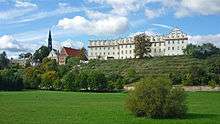
- Wyższa Szkoła Humanistyczno-Przyrodnicza Studium Generale Sandomiriense
- Wyższe Seminarium Duchowne w Sandomierzu
- 1 Liceum Ogolnoksztalcace Collegium Gostomianum
- 2 Liceum Ogólnokształcące im. Tadeusza Kościuszki
- Zespół Szkół Gastronomicznych i Hotelarskich
- Zespół Szkół Technicznych i Ogólnokształcących
International relations
Twin towns — Sister cities
Sandomierz is twinned with:
Gallery
 Town Hall
Town Hall Market Square (Rynek)
Market Square (Rynek)
 Church of the Conversion of Saint Paul
Church of the Conversion of Saint Paul- St. Jacob's Church, 13th–14th century
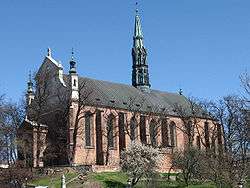
 Cathedral, interior
Cathedral, interior Jan Długosz house
Jan Długosz house Historic well at the main square
Historic well at the main square Church of St. Michael
Church of St. Michael Townhouses at the main market square
Townhouses at the main market square Bishops' Palace
Bishops' Palace.jpg) Post office
Post office House at 31 Rynek
House at 31 Rynek
Notable residents
- Karol Bielecki (born 1982), handball player
- Mikołaj Gomółka (1591–1609), Polish Renaissance composer
- Wincenty Kadłubek (1150–1223), mediaeval chronicler
- Wacław Król (1915–1991), Polish military pilot
- Wiesław Myśliwski (born 1932), writer, Nike Award laureate
- Piotr Nurowski (1945–2010), tennis player, President of the Polish Olympic Committee
- Sebastian Petrycy (1554–1626), philosopher and physician
- Gracjan Piotrkowski (1734–1785), Catholic polemicist
- Mikołaj Trąba (1358–1422), Polish Roman Catholic priest, first Primate of Poland
Webcams
Virtual walks
See also
References
- "Sandomierz (świętokrzyskie)". Polska w liczbach (in Polish). Retrieved 3 November 2019.
- Stanisław Rospond, Słownik etymologiczny miast i gmin PRL, Wrocław 1984, ISBN 83-04-01090-9.
- Stan Lewicki, Historja handlu w Polsce na tle przywilejów handlowych: (prawo składu), Warszawa 1920, p. 134 (in Polish)
- Blessed Sadoc and Companions "the 49 martyrs of Sandomir" http://www.sistersofmary.org/index.php?option=com_content&view=article&id=105&Itemid=76
- "Sandomierski skład soli". Sandomierz.pl (in Polish). Retrieved 8 November 2019.
- "Jagiełło". Na stronach ksiąg i Internetu. Bitwa pod Grunwaldem przez wieki (in Polish). Retrieved 3 November 2019.
- Fr Edward Górecki Ph.D, A Guide to Sandomierz Cathedral.
- Joanna Toarska-Bakir Ph.D., Sandomierz Blood-Libel Myths. Final Report 2006 by University of Warsaw.
- Poland and the Jews p.199, Stanislaw Krajewski, Kraków 2005
- Polonsky, Antony (2010). The Jews in Poland and Russia Volume 1. Portland, Oregon: The Littman Library of Jewish Civilization. pp. 25–26. ISBN 978-1-874774-64-8.
- "Sandomierz climate: Average Temperature, weather by month, Sandomierz weather averages - Climate-Data.org". en.climate-data.org. Retrieved 2019-01-13.
- "City (12585) - WMO Weather Station". NOAA. Retrieved January 13, 2010. Archived December 27, 2018, at the Wayback Machine.
- "Home". newarktwinning.co.uk. 2009. Retrieved 29 August 2011.
External links
| Wikimedia Commons has media related to Sandomierz. |
| Wikisource has the text of the 1911 Encyclopædia Britannica article Sandomir. |
- Sandomierz city council
- Sandomierz Forum - City life
- Tourist Web Site
- Tourist Guide Site
- Collegium Gostomianum
- Secondary School in Sandomierz no 2
- Zespół Szkół Gastronomicznych i Hotelarskich
- https://web.archive.org/web/20140814213806/http://www.archiwumetnograficzne.edu.pl/downloads/sandomierz_angl.pdf
- "Some Glimpses at the Life of the Jewish Community of Sandomierz in the Years 1918-1939"
- Pozytywny Sandomierz
- Sandomierz, Poland at JewishGen

